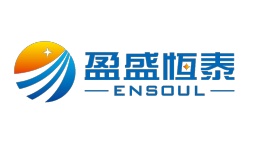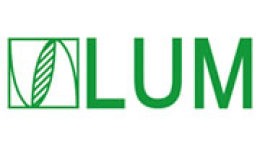方案详情文
智能文字提取功能测试中
APPLICATION NOTEF&F-S-005-2016/A1 TOTAL FAT DETERMINATION IN CONDENSED MILKRANDALL METHOD Total Fat DeterminationinCondensed Mikaccording to the Randall method Reference: AOAC 933.05 Fat in Cheese Tested with VELP Scientifica SER 158/6 Solvent AutoExtractor (Code S303A0380) and HU6 Hydrolysis Unit(Code F30300110) Introduction Condensed milk is cow's milk from which water has been removed. It is most often found in the form of sweetenedcondensed milk (SCM), with sugar added. Sweetened condensed milk is a very thick, sweet product which when cannedcan last for years without refrigeration if unopened. The production of condensed milk is obtained starting from raw milk that is clarified and standardized and is then heatedto 85-90 °C for several seconds. This heating process destroys some microorganisms, decreases fat separation andinhibits oxidation. Some water is evaporated from the milk and sugar is added until a 9:11 (nearly half) ratio of sugar to(evaporated) milk is reached. The sugar extends the shelf life of sweetened condensed milk.Nowadays condensed milk is used in numerous dessert dishes in many countries all over the world. Fat Determination in Condensed milk Hot solvent extraction process with SER 158 Series can be summed up in 5 steps, for a fully automatic process completelyunattended: During IMMERSION the sample is immersed in boiling solvent. Then the REMOVING step automatically lowers the levelof the solvent to below the extraction thimble.During WASHING the condensed solvent flows over the sample and throughthe thimble to complete the extraction process. The fourth step involves solvent RECOVERY. Approximately 90% of thesolvent used is collected in the internal recovery tank. The final step is the COOLING of the extraction cups containing theextracted matter. The cups are raised to prevent burning. The extraction cups containing the extract are placed in a dryingoven, cooled in a desiccator and weighed for the extract percentage calculation. Sample Condensed milk Fat labeled content: 8 % In order to determine the total fat in food and feed samples a direct extraction with solvents is not efficient because a partof lipids is chemically bonded with other components. The determination of the total fat content of these samples, requiresa preliminary hydrolysis using hydrochloric acid 4 N, followed by filtration and washing, in order to free completely the fatmolecules. Then the hydrolyzed sample is ready for the extraction and it can be easily transferred to SER 158 SolventAutoExtractor avoiding any possible sample loss and ensuring improved accuracy of results (see the following picture). Chemicals and Equipment Required ●Analytical balance, min. 3 decimals Test tube 250 ml (Code A000000144) ● Glass sand, 0.4-0.8 mm (Code A00000089) Glass bottle for waste collector (Code A0000088)●·Celite 545 (Code A00000097) ● Glass extraction cups (Code A00000290)。 Glass crucibles P1 (Code A00000086) Viton sealse Hydrochloric acid 4N ·PPetroleum Ether 40 -60 °C as solventAll the accessories required for the hydrolysis are included in the kit code A00000085. Sample Preparation ●HHydrolysis Crucibles Preparation Put 25 g of glass sand in glass crucibles P1 and 3g of Celite 545: the two layers resulting have not be mixed togetherotherwise the phase in Celite may bypass the crucible negatively affecting the end result. · Sample Preparation in Test Tube Mix the sample with a spoon and weigh 5 g of homogenized sample (Msample) and 2 g of Celite 545 in the test tube. In eachtest tube add 50 ml of 4N hydrochloric acid, shake gently and carefully, and finally add a further 50 ml hydrochloric acidin order to rinse the sample residue that may remain on the walls of the test tube. ●· Glass Extraction Cups Preparation Keep the empty glass extraction cups in oven at 105 °℃ for 1 hour. Cool them in a desiccator and record the accurateweight of the tare (Mtare). Hydrolysis Procedure with HU 6 Place 6 crucibles P1 on the HU6 and connect the aspirating tubes: one side needs to be placed on the sealing ring ofthe crucible and the other one has to be in contact with the corresponding test tube. Set 170 °C for 60 minutes. Place the 6 test tubes in the heating block, lower the glassware and activate the vacuum pump. In case of foam, add 4 N hydrochloric acid drop by drop inside the test tubes. . At the end of the procedure, switch off and allow aspiration of the content of the test tubes in the crucible.Raise the glassware to its maximum point and secure it, by tightening the knob. Then, add hot water (40-50°C, about 250 ml) slowly, in order to aspirate all the residues of hydrolysis in the test tubes.Remove the aspirating tubes and the crucibles containing the sample after the washing: mix the layer of hydrolyzed sample with the layer of Celite by using a spatula in order to break any clot. Take care to not damage the layer of glass sand. This operation helps the sample drying, which must take place in an oven at 105 °C for a time between 1.5 to 6 hours. lf dried test portions will not be immediately extracted, put them in a desiccator, or let the crucibles cool to roomtemperature and then, mix the layer of hydrolyzed sample and Celite with a spatula to obtain a powdery hydrolyzed Take care not damage the layer of glass sand. Extraction Procedure with SER 158 Fix the crucibles with the crucible holders (Code A00000293). The extraction cups containing the crucibles can now beplaced on the ultra-fast heating plate of SER 158. On the ControlPad select “Analysis”, and then method"Total fat in condensed milk”including the following parameters: ●· Immersion Time: 60 minutes ●Recovery Time 30 minutes RRemoving Time: 10 minutesCooling Time: 5 minutes●VWashing Time: 50 minutesPetroleum Ether 40-60°C, 100 ml Close the safety guard and add the solvent using the automatic solvent dispensing system SolventXpress TM to minimizeexposure to the solvent ensuring operator safety.Press START to begin the extraction process. At the end of analysis position the extraction cups containing the extract ina drying oven (1 hour at 105°C), cool them in a desiccator to room temperature and record the accurate weight (Mtot). Typical Results on Condensed milk Analysis results are calculated automatically and stored in the ControlPad when entering the weights into the software(manually or automatically through a balance). The extract percentage calculation is performed by using the followingformulas: Where: Sample = sample weight (g) Tare= weight of the empty extraction cup(g) Total = weight of the extraction cup +extract (g) Tare (g) Sample (g) Total (g) Extract (g) Extract (%) 130.4428 4.983 130.8206 0.3778 7.58 131.0601 5.101 131.4605 0.4004 7.85 130.0668 5.258 130.4664 0.3996 7.60 130.4763 5.116 130.8666 0.3903 7.63 128.8978 5.332 129.3046 0.4068 7.63 132.0689 5.868 132.5112 0.4423 7.54 Average ± SD% 7.60±0.04 RSD%** 0.50 Fat Labeled content: 8 % Fat Labeled content: 8 % ** RSD%= (Standard Deviation x 100)/ Average Conclusion The results obtained are reliable and reproducible in accordance with the expected values, with a low relative standarddeviation (RSD< 1%), that means high repeatability of the results. Therefore, SER 158 Solvent AutoExtractor and HU6 hydrolyses unit are ideal for the fat content determination incondensed milk. Benefits of HU 6 Hydrolysis Unit are: -safety with performance, reducing manual handling to the minimum -no sample transfer required when passing from HU 6 to SER 158 -suitable for both acid and basic hydrolysis Benefits of hot solvent extraction (Randall) by using SER 158 Solvent AutoExtractor: - up to 5 times faster than Soxhlet (hot solvent vs. cold solvent) - low solvent consumption (high solvent recovery, approximately 90%)-limited cost per analysis - no exposure to solvent -worldwide official method -full traceability with automatic result calculation and on-board archive 炼乳是去掉了水的牛奶。它最常以加糖炼乳的形式出现。加糖炼乳是一种非常粘稠、甜的产品,如果不开封,罐装后可以保存好几年。炼乳的生产从澄清和标准化的原料奶开始,然后加热到85-90摄氏度几秒钟。这个加热过程会破坏一些微生物,减少脂肪分离并抑制氧化。从牛奶中蒸发一些水,然后加入糖,直到糖和(蒸发的)牛奶的比例达到9:11(接近一半)。糖可以延长炼乳的保质期。如今,炼乳在世界上许多国家的许多甜点中都有使用。参考标准:AOAC 933.05 Fat in Cheese检测仪器:SER 158脂肪测定仪、 HU 6水解装置 (意大利VELP)检测样品:Condensed milk Fat labeled content: 8 %实验结果:结果可靠,重现性好,相对标准偏差(RSD < 1%),这意味着结果的高重复性。因此,SER 158脂肪测定仪和HU6水解装置是测定炼乳中脂肪含量的理想设备。HU 6水解装置的好处有:-性能安全,将手动操作减少到最低限度-从HU 6传递到SER 158时不需要样品转移-适合酸水解和碱水解SER 158脂肪测定仪热溶剂萃取的好处(兰德尔):-比索氏快5倍(热溶剂对冷溶剂)-低溶剂消耗(高溶剂回收率,约90%)-每次分析的成本较少-不接触溶剂-符合标准方法-完整的可追溯性,自动计算结果和存档
关闭-
1/4
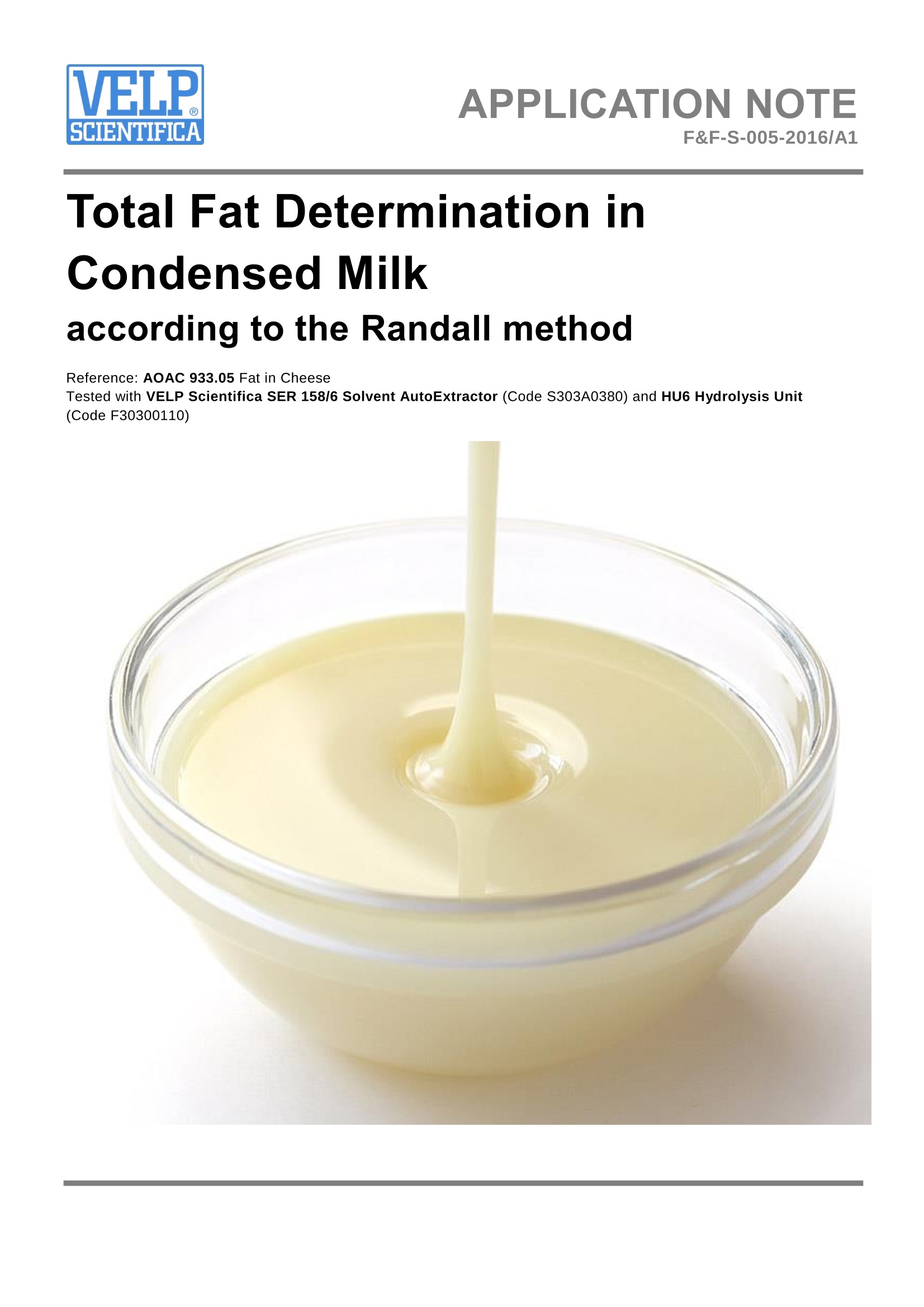
-
2/4
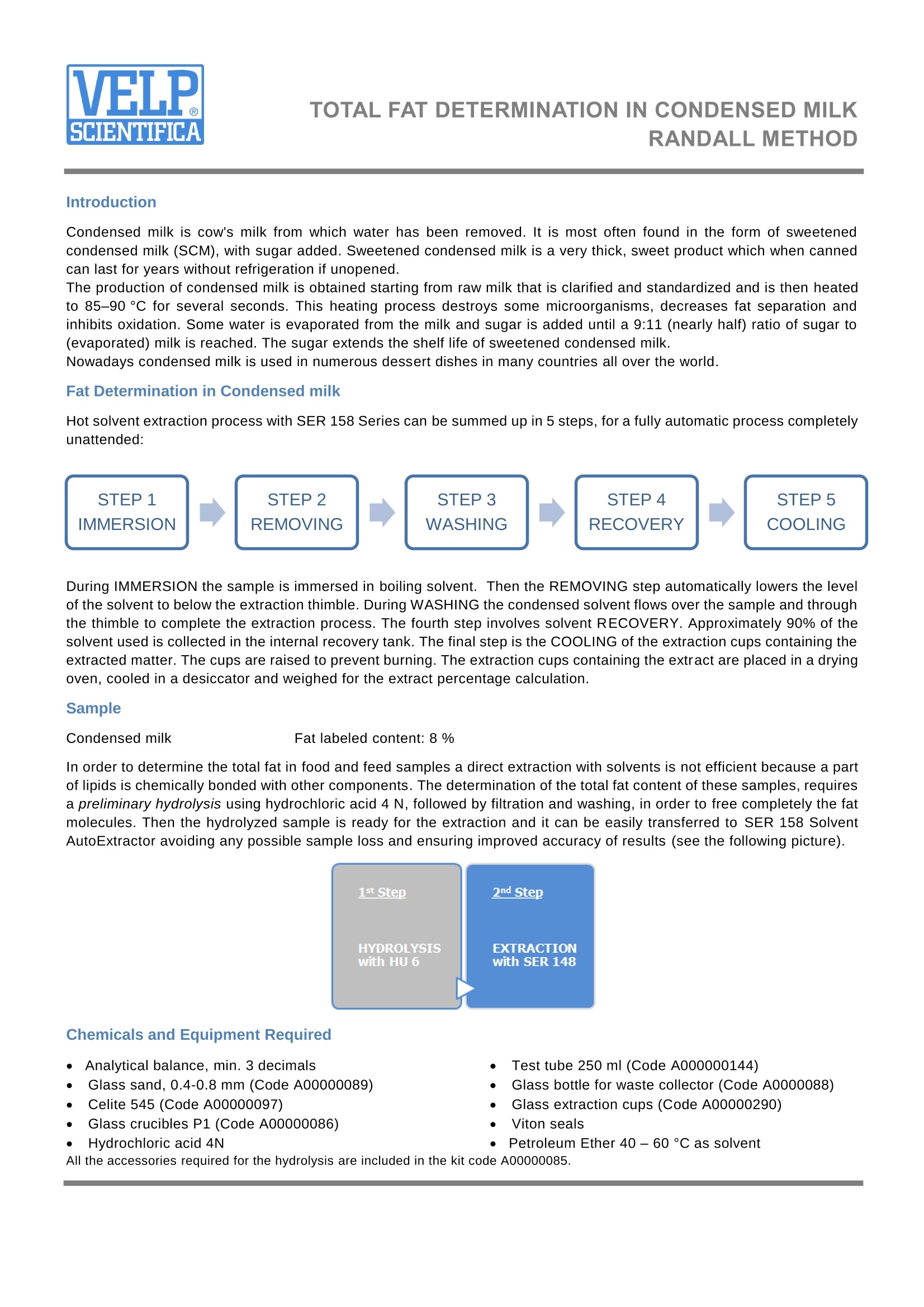
还剩2页未读,是否继续阅读?
继续免费阅读全文产品配置单
北京盈盛恒泰科技有限责任公司为您提供《炼乳中总脂肪检测方案(抽提萃取)》,该方案主要用于其他乳制品中营养成分检测,参考标准《暂无》,《炼乳中总脂肪检测方案(抽提萃取)》用到的仪器有全自动脂肪测定仪-SER158、VELP-脂肪测定仪SER148/6。
我要纠错
推荐专场
抽提萃取、索氏提取、脂肪测定仪
更多相关方案


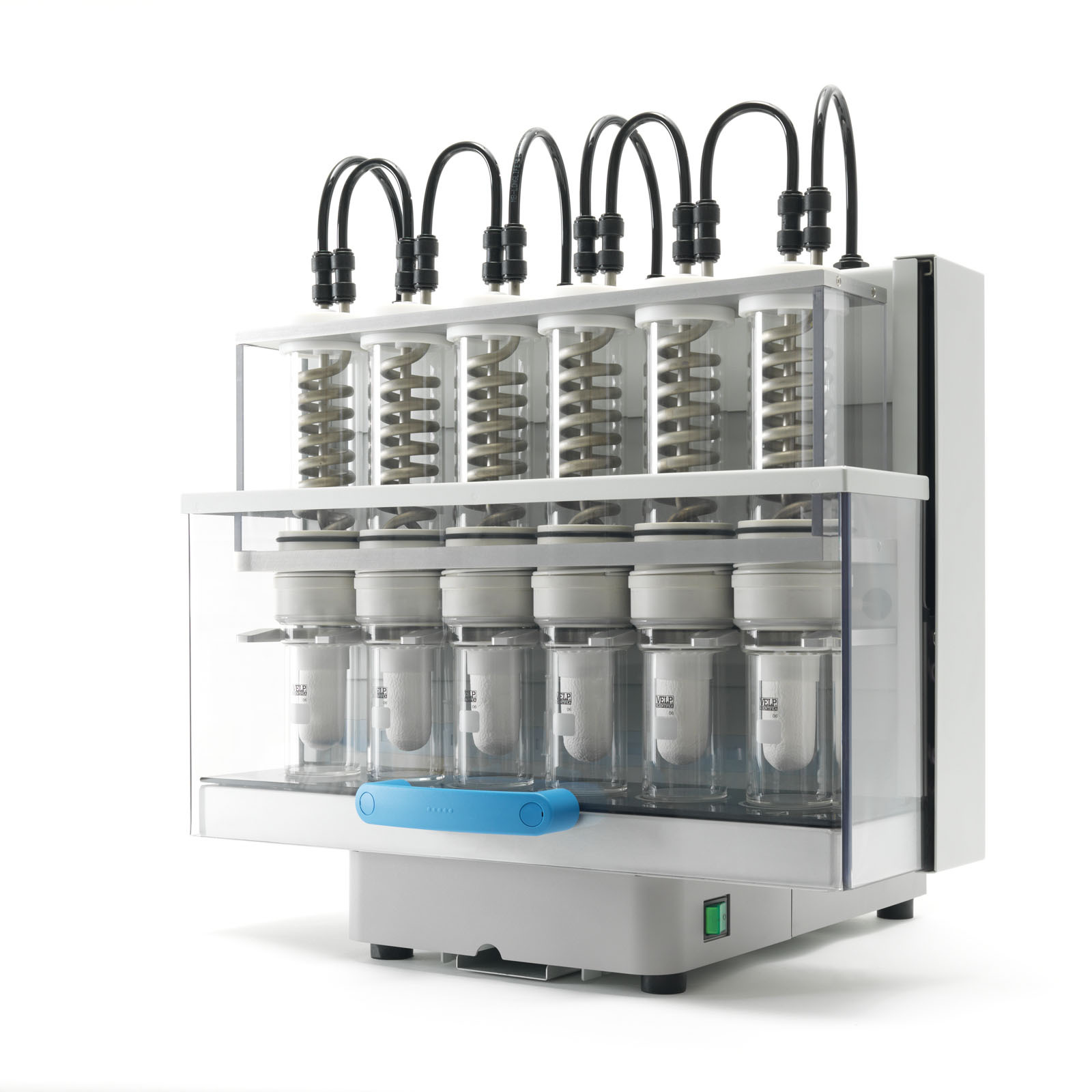
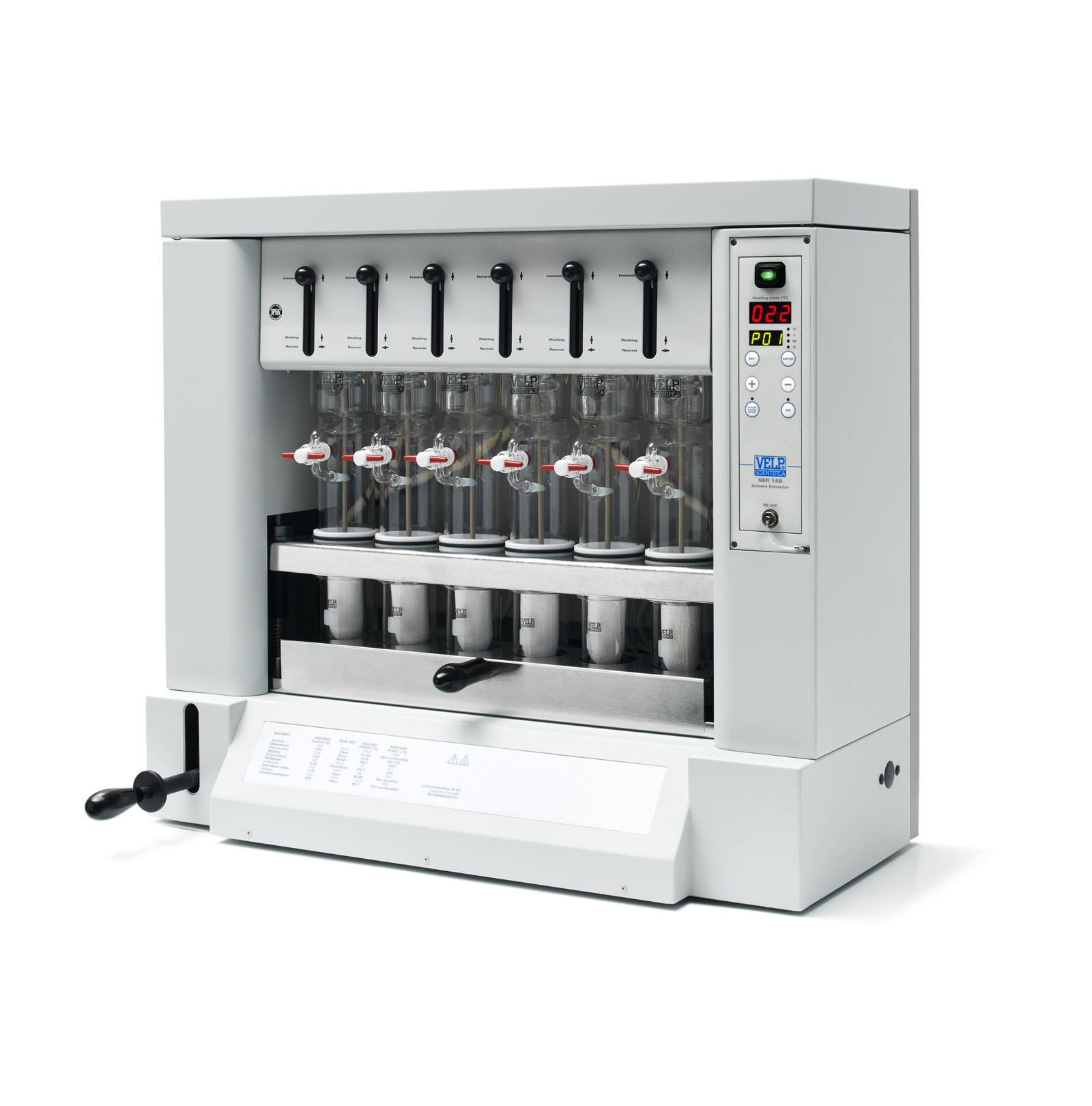

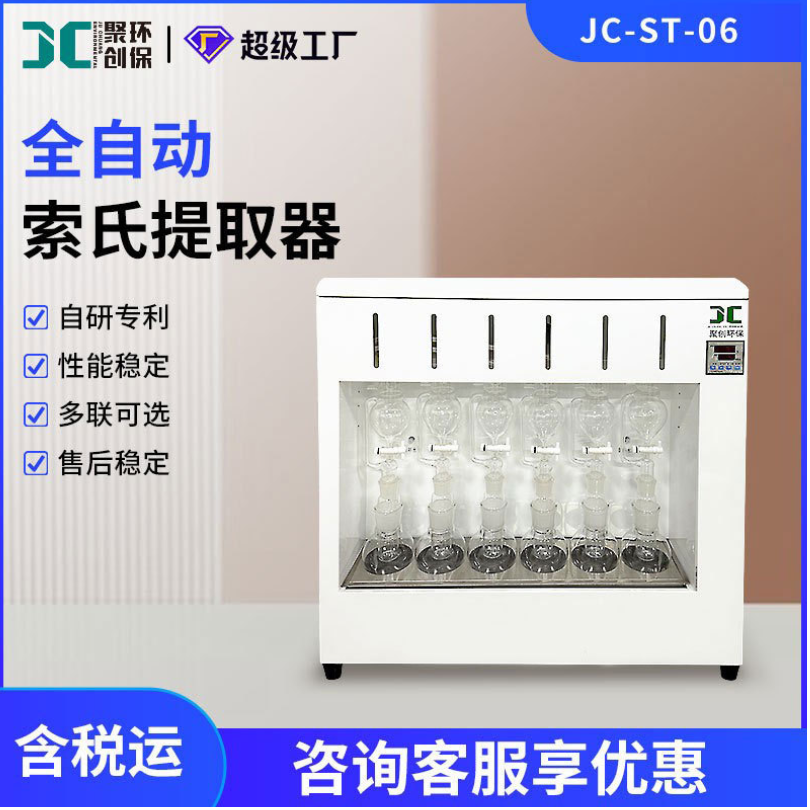

 咨询
咨询